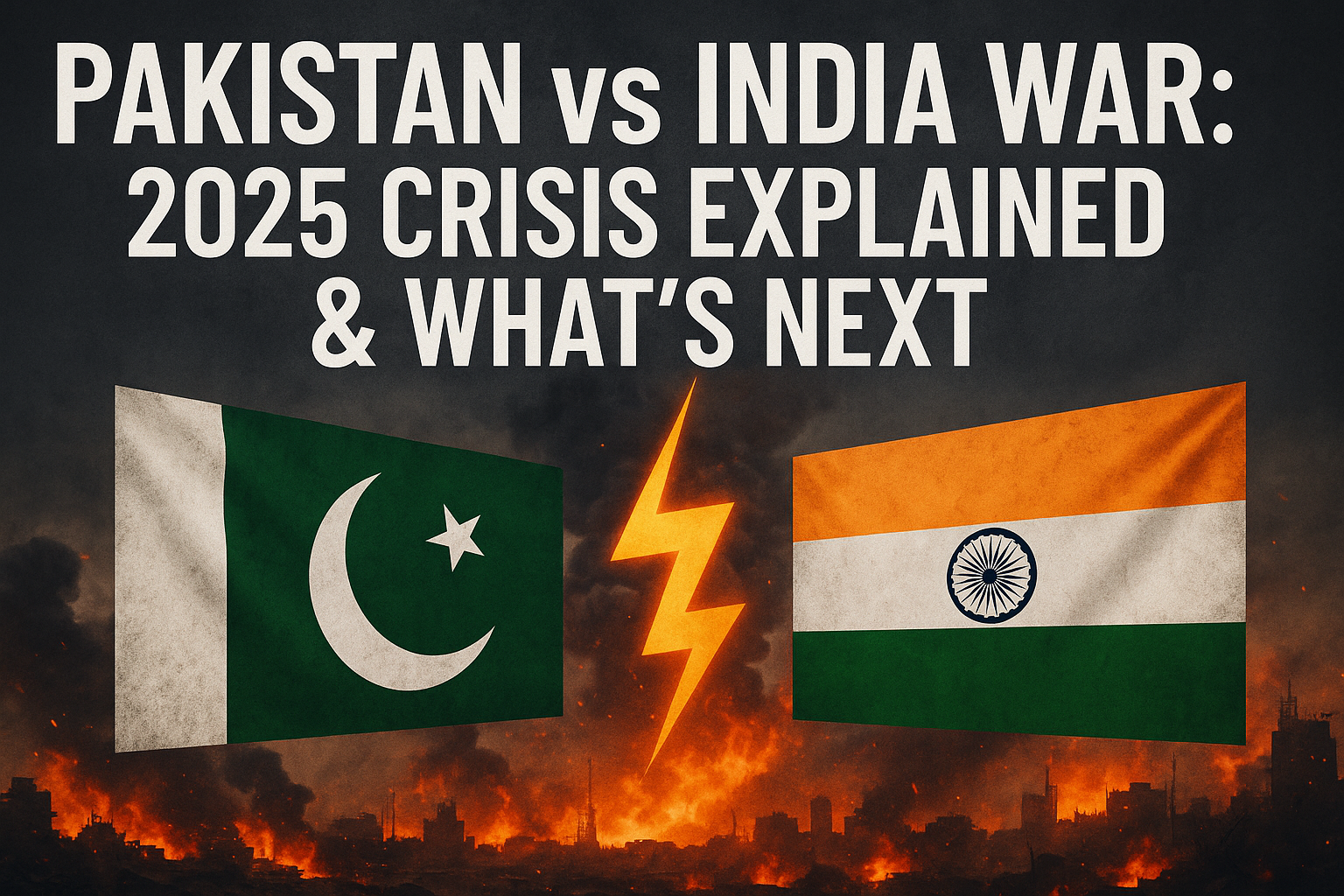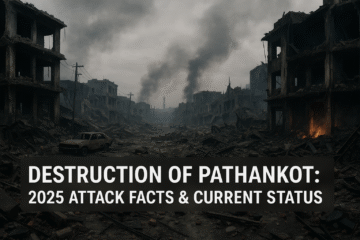
Pakistan vs India War: 2025 Crisis Explained & What’s Next
Introduction to the Pakistan vs India War
Historical Context of the Pakistan vs India War
Triggering Event: The Pahalgam Attack and Its Fallout
-
India’s Response: India suspended the Indus Waters Treaty, closed the Attari-Wagah border, expelled Pakistani diplomats, and canceled visa services. Indian Prime Minister Narendra Modi vowed to punish the perpetrators “beyond their imagination”.
-
Pakistan’s Countermeasures: Pakistan reciprocated by suspending trade, closing its airspace to Indian flights, and expelling Indian diplomats. It warned that any alteration of Indus River flows would be considered an “act of war”.
Military Engagements in the Pakistan vs India War
1. India’s Airstrikes: Operation Sindoor (May 7, 2025)
-
Casualties and Damage: Pakistan reported 31 deaths, including two children, and 57 injuries, with damage to civilian infrastructure, including a mosque in Muzaffarabad. Pakistan denied the targets were militant camps, labeling the strikes an “act of war”.
-
Pakistan’s Claims: Pakistan’s military claimed it shot down five Indian Air Force jets, including three Dassault Rafales, one MiG-29, and one SU-30MKI, during the strikes. India denied these losses, with the Indian embassy in Beijing calling such reports “misinformation”. A French intelligence official and a US official corroborated Pakistan’s claim of downing at least one Rafale, though India attributed any crashes to technical issues.
2. Pakistan’s Alleged Drone and Missile Attacks (May 8, 2025)
-
Pakistan’s Denial: Pakistan’s Defence Minister Khawaja Asif denied involvement, stating, “We have not mounted anything so far,” and promised that any Pakistani strike would be overt and undeniable. Unverified reports suggested Pakistan used loitering munitions, but these claims lack confirmation.
-
Context: These alleged attacks, if true, would represent Pakistan’s retaliation for India’s airstrikes, escalating the Pakistan vs India war further.
3. Cross-Border Shelling and Artillery Fire
-
Indian Reports: India claimed Pakistani shelling killed at least 16 civilians and injured 43 in Poonch, Kupwara, Baramulla, Uri, and Akhnoor. Indian forces responded with artillery fire, targeting Pakistani positions.
-
Pakistani Reports: Pakistan reported civilian and military casualties from Indian shelling but provided no specific figures. The shelling damaged infrastructure in Pakistani-administered Kashmir.
-
Impact: The continuous exchange of fire has disrupted civilian life, with blackouts enforced in border areas like Jammu and schools closed in Indian-administered Kashmir.
4. Pakistan’s Drone Interceptions (May 8, 2025)
5. Claims of Military Successes
-
Pakistan’s Claims: On May 9, 2025, Pakistan claimed to have killed “40-50 Indian soldiers” along the border in retaliation for India’s strikes. These claims lack independent verification.
-
India’s Claims: India reported neutralizing Pakistani drones and missiles and striking air defense systems in Pakistan, though specifics were not disclosed.
Strategic Implications of the Pakistan vs India War
1. Nuclear Risk
2. Regional Power Dynamics
-
India’s Focus on China: India’s military modernization, including Rafale jets and S-400 systems, is primarily aimed at countering China, but these assets are now engaged in the Pakistan vs India war. India’s strikes may also signal its capabilities to Beijing.
-
Pakistan’s Alliance with China: Pakistan’s J-10 jets and drones reflect its growing reliance on Chinese technology, strengthening the China-Pakistan axis. This alignment complicates the Pakistan vs India war, as China has called for restraint but supports Pakistan’s security concerns.
3. Domestic Pressures
-
India: Prime Minister Modi’s Hindu nationalist agenda and public outrage over the Pahalgam attack have pushed India toward aggressive action. Operation Sindoor’s name, referencing vermilion (a symbol of Hindu widowhood), underscores its symbolic weight.
-
Pakistan: Pakistan faces internal instability, with a fragile economy and political turmoil following Imran Khan’s ousting. The military and Inter-Services Intelligence (ISI) are under pressure to respond decisively to maintain credibility.
International Response to the Pakistan vs India War
-
United States: US Secretary of State Marco Rubio urged “immediate de-escalation” in calls with Indian and Pakistani leaders on May 7, 2025. President Donald Trump called India’s strikes “a shame” but emphasized the conflict as “none of our business”. The US has historically mediated Pakistan vs India war crises, but its current neutral stance has limited its influence.
-
China: China expressed support for Pakistan’s security concerns and called for restraint, reflecting its strategic partnership with Pakistan.
-
Russia: Russia, a key arms supplier to India, urged both sides to show restraint, maintaining its historically close ties with New Delhi.
-
Turkey and Iran: Turkey condemned India’s strikes, while Iran offered to mediate peace talks, with Foreign Minister Abbas Araghchi visiting both countries.
-
G7 and UN: The G7 nations and UN Secretary-General Antonio Guterres called for direct dialogue and an independent investigation into the Pahalgam attack.
Current Status of the Pakistan vs India War (May 10, 2025)
-
Military Standoff: Both countries remain on high alert, with blackouts and civil defense drills in Indian states like Delhi, Rajasthan, and Goa. Pakistan has secured its borders and airspace.
-
Casualty Toll: India reports 16 civilian deaths from Pakistani shelling, while Pakistan claims 31 deaths from India’s strikes and shelling. Unverified claims of military casualties persist.
-
Diplomatic Efforts: International mediation efforts continue, but no breakthrough has been achieved, with both sides entrenched in their positions.
Challenges and Risks in the Pakistan vs India War
-
Lack of Crisis Mechanisms: Unlike the Cold War, India and Pakistan lack robust bilateral communication channels, increasing the risk of miscalculation.
-
Nuclear Flashpoint: South Asia is considered the world’s most likely nuclear flashpoint, with any escalation in the Pakistan vs India war potentially catastrophic.
-
Pakistan’s Military Constraints: Pakistan’s artillery ammunition reserves are reportedly low, limiting its ability to sustain a prolonged Pakistan vs India war.
-
Public Pressure: Domestic demands for retaliation in both countries fuel the Pakistan vs India war, making de-escalation politically challenging.
Future Prospects for the Pakistan vs India War
-
De-escalation: Strong international pressure, particularly from the US, China, or Gulf states, could lead to a ceasefire, as seen in past Pakistan vs India war crises (e.g., 1999, 2019). Iran’s mediation offer and the UAE’s prior success in 2021 provide potential avenues.
-
Limited Conflict: The Pakistan vs India war could remain confined to cross-border strikes and shelling, avoiding a full-scale war due to nuclear deterrence and economic constraints.
-
Escalation: A miscalculation, such as a significant civilian casualty event or a successful strike on a high-value target, could escalate the Pakistan vs India war into a broader conflict.
Conclusion: Navigating the Pakistan vs India War
Frequently Asked Questions (FAQs) About the India-Pakistan Conflict (May 2025)
1. What triggered the latest escalation between India and Pakistan?
The conflict escalated after a terrorist attack on April 22, 2025, in Pahalgam, Indian-administered Kashmir, where 26 civilians (mostly Hindu tourists) were killed. India blamed Pakistan-based militant groups Lashkar-e-Taiba (LeT) and Jaish-e-Mohammed (JeM) for the attack, though Pakistan denied involvement 19.
2. What military actions have occurred so far?
-
May 7, 2025: India launched “Operation Sindoor”, striking nine targets in Pakistan and Pakistan-administered Kashmir, including militant camps in Bahawalpur and Muridke 37.
-
Pakistan retaliated by shooting down Indian drones and jets, claiming to have destroyed Indian checkpoints along the Kashmir border 59.
-
Casualties: Pakistan reports 31 civilian deaths, while India claims 16 civilians killed by Pakistani shelling 59.
3. Are India and Pakistan at risk of full-scale war?
Experts warn this is the most dangerous crisis since 2002, with both nations nuclear-armed. However, neither side can afford a prolonged war due to economic and geopolitical risks 412. De-escalation efforts are ongoing, but Pakistan’s military leadership has vowed to match aggression 14.
4. How has the international community responded?
-
U.S.: President Trump has been dismissive, stating, “They’ve been fighting for a long time” 1112.
-
Gulf States: Qatar, UAE, and Saudi Arabia are mediating, given their ties to both nations 112.
-
China: Urged restraint but is seen as biased toward Pakistan 1.
5. What are the historical roots of this conflict?
-
Kashmir Dispute: Both nations claim the region in full but control parts of it since 1947 29.
-
Past Wars: Fought three major wars (1947, 1965, 1971) and a limited conflict in 1999 (Kargil War) 2.
-
2019 Pulwama Attack: Similar tensions followed a suicide bombing, leading to aerial clashes 37.
6. What are the economic and humanitarian impacts?
-
Travel Disruptions: Flights canceled, airports closed in northern India 5.
-
Diplomatic Cuts: Expulsion of diplomats, visa bans, and trade suspensions 9.
-
Civilian Suffering: Families near the border are fleeing shelling, with reports of bunker use 5.
7. What’s next?
-
Pakistan’s Retaliation: Expected to target military installations, not civilians 311.
-
De-escalation Hopes: Gulf mediation or U.S. involvement could help 12.
-
Long-term Risks: Revoked treaties (e.g., Indus Waters Treaty) could worsen tension



